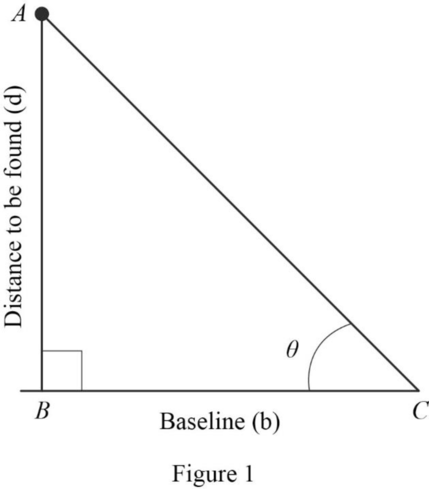
Concept explainers
To explain the distance measurement method by triangulation.
Answer to Problem 1QFR
The triangulation technique is a distance measurement method which is used to calculate the distance between the stars. In this technique a right angle triangle is constructed such that distance of one of its side is computed which cannot be measured directly.
Explanation of Solution
The triangulation technique is used for estimating the distance between the stars. In this method a right angle triangle is constructed such that distance of one of its side is computed which cannot be measured directly.
Figure 1 represents the constructed triangle to compute the unknown distance.

In Figure 1, the baseline length BC is taken as b, and the distance to be measured AB is taken as d.
From the above figure 1,
In Figure 1, the length of AB need to be found, with baseline length BC is known. Then the length of AB can be calculated using the length of baseline and the angle at point C
Conclusion:
Therefore, the triangulation technique is a distance measurement method which is used to calculate the distance between the stars. In this technique a right angle triangle is constructed such that distance of one of its side is computed which cannot be measured directly.
Want to see more full solutions like this?
Chapter 13 Solutions
Loose Leaf For Explorations: Introduction To Astronomy
- Part A Consider the mechanism shown in (Figure 1). If a force of F = 350 N is applied to the handle of the toggle clamp, determine the resulting clamping force at A. Express your answer to three significant figures and include the appropriate units. Figure -235 mm- 30 mm 70 mm 30 mm/ 30 275 mm 1 of 1 > ΜΑ ? FA= Value Units Submit Request Answer Return to Assignment Provide Feedbackarrow_forwardgot 4.67 for 1 then 9.33 for the rest then 21.33 for the input and output but it says all are wrongarrow_forwardmase as shown 2) A holy of once sty extually at rest & acted upon by bus mutually perpendicular forces 12 Nand 5N belowilf the particle moves in derection Calculato the magnitude of the acceleration of 12nt R 0 so A SNarrow_forward
- Required information Two speakers vibrate in phase with each other at 523 Hz. At certain points in the room, the sound waves from the two speakers interfere destructively. One such point is 1.45 m from speaker #1 and is between 2.00 m and 4.00 m from speaker #2. The speed of sound in air is 343 m/s. How far is this point from speaker #2? marrow_forwarda) Consider the following function, where A is a constant. y(x,t) = A(x — vt). Can this represent a wave that travels along? Explain. b) Which of the following are possible traveling waves, provide your reasoning and give the velocity of the wave if it can be a traveling wave. e-(a²x²+b²²-2abtx b.1) y(x,t) b.2) y(x,t) = = A sin(ax² - bt²). 2 b.3) y(x,t) = A sin 2π (+) b.4) y(x,t) = A cos² 2π(t-x). b.5) y(x,t) = A cos wt sin(kx - wt)arrow_forwardThe capacitor in (Figure 1) is initially uncharged. The switch is closed at t=0. Immediately after the switch is closed, what is the current through the resistor R1, R2, and R3? What is the final charge on the capacitor? Please explain all steps.arrow_forward
- Suppose you have a lens system that is to be used primarily for 620-nm light. What is the second thinnest coating of fluorite (calcium fluoride) that would be non-reflective for this wavelength? × nm 434arrow_forwardThe angle between the axes of two polarizing filters is 19.0°. By how much does the second filter reduce the intensity of the light coming through the first? I = 0.106 40 xarrow_forwardAn oil slick on water is 82.3 nm thick and illuminated by white light incident perpendicular to its surface. What color does the oil appear (what is the most constructively reflected wavelength, in nanometers), given its index of refraction is 1.43? (Assume the index of refraction of water is 1.33.) wavelength color 675 × nm red (1 660 nm)arrow_forward
- A 1.50 μF capacitor is charging through a 16.0 Ω resistor using a 15.0 V battery. What will be the current when the capacitor has acquired 1/4 of its maximum charge? Please explain all stepsarrow_forwardIn the circuit shown in the figure (Figure 1), the 6.0 Ω resistor is consuming energy at a rate of 24 J/s when the current through it flows as shown. What are the polarity and emf of the battery E, assuming it has negligible internal resistance? Please explain all steps. I know you need to use the loop rule, but I keep getting the answer wrong.arrow_forwardIf you connect a 1.8 F and a 2.6 F capacitor in series, what will be the equivalent capacitance?arrow_forward
 Foundations of Astronomy (MindTap Course List)PhysicsISBN:9781337399920Author:Michael A. Seeds, Dana BackmanPublisher:Cengage Learning
Foundations of Astronomy (MindTap Course List)PhysicsISBN:9781337399920Author:Michael A. Seeds, Dana BackmanPublisher:Cengage Learning Stars and Galaxies (MindTap Course List)PhysicsISBN:9781337399944Author:Michael A. SeedsPublisher:Cengage Learning
Stars and Galaxies (MindTap Course List)PhysicsISBN:9781337399944Author:Michael A. SeedsPublisher:Cengage Learning
 An Introduction to Physical SciencePhysicsISBN:9781305079137Author:James Shipman, Jerry D. Wilson, Charles A. Higgins, Omar TorresPublisher:Cengage Learning
An Introduction to Physical SciencePhysicsISBN:9781305079137Author:James Shipman, Jerry D. Wilson, Charles A. Higgins, Omar TorresPublisher:Cengage Learning AstronomyPhysicsISBN:9781938168284Author:Andrew Fraknoi; David Morrison; Sidney C. WolffPublisher:OpenStax
AstronomyPhysicsISBN:9781938168284Author:Andrew Fraknoi; David Morrison; Sidney C. WolffPublisher:OpenStax





